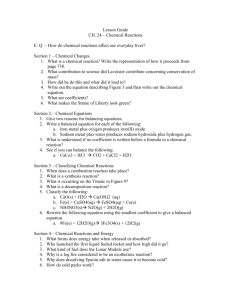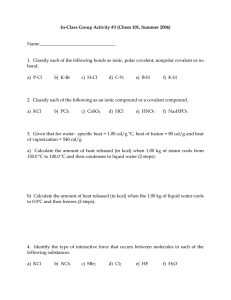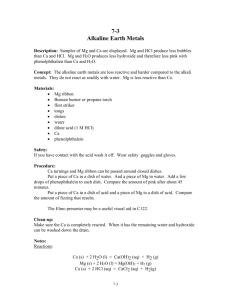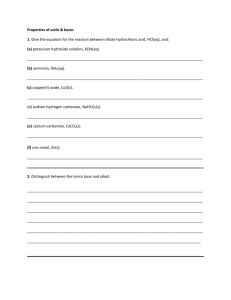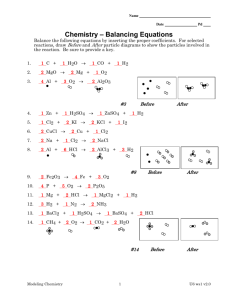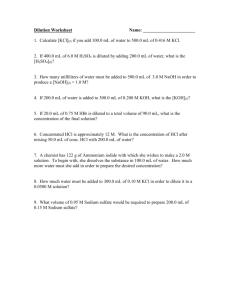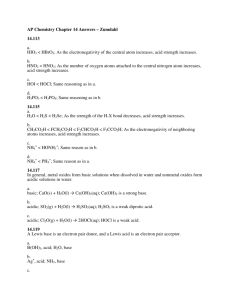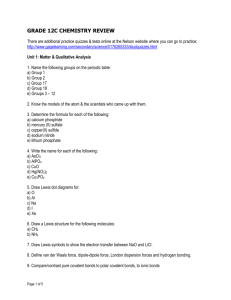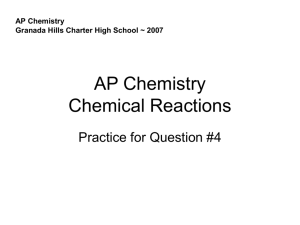File
advertisement
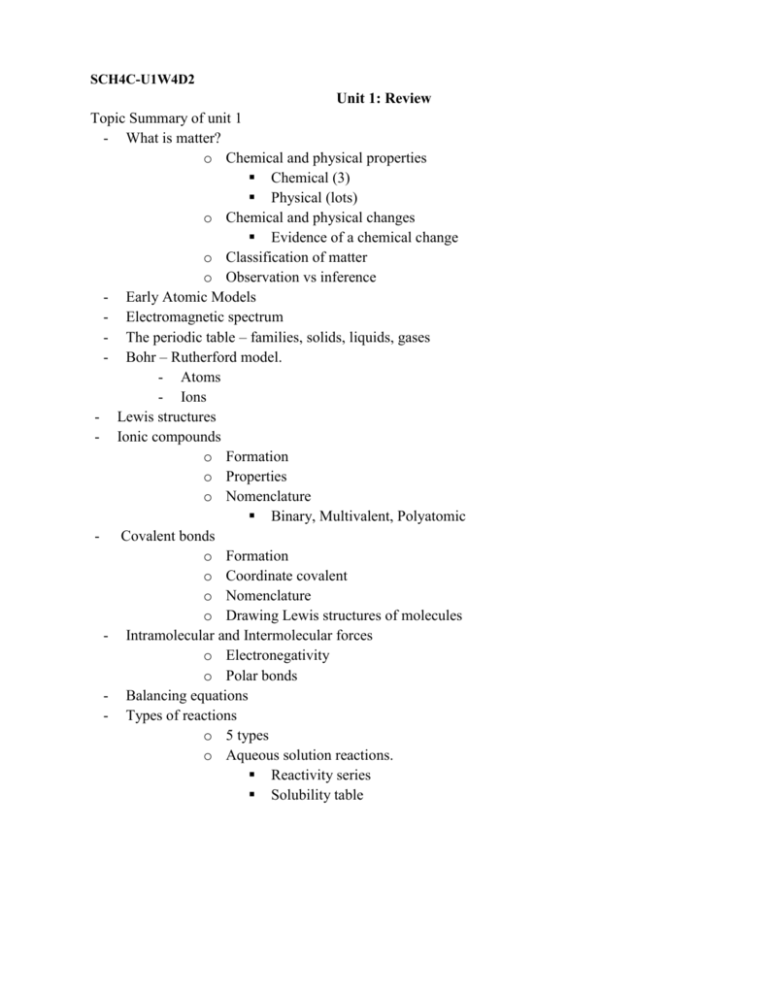
SCH4C-U1W4D2 Unit 1: Review Topic Summary of unit 1 - What is matter? o Chemical and physical properties Chemical (3) Physical (lots) o Chemical and physical changes Evidence of a chemical change o Classification of matter o Observation vs inference - Early Atomic Models - Electromagnetic spectrum - The periodic table – families, solids, liquids, gases - Bohr – Rutherford model. - Atoms - Ions - Lewis structures - Ionic compounds o Formation o Properties o Nomenclature Binary, Multivalent, Polyatomic - Covalent bonds o Formation o Coordinate covalent o Nomenclature o Drawing Lewis structures of molecules - Intramolecular and Intermolecular forces o Electronegativity o Polar bonds - Balancing equations - Types of reactions o 5 types o Aqueous solution reactions. Reactivity series Solubility table Date: SCH4C-U1W4D2 Unit 1 Practice Problems Chemical and physical changes 1. An egg is cooked 2. Ice melts 3. Ice is smashed 4. Salt is dissolved in water 5. Alcohol is mixed with water 6. Banana’s start to rot 7. Methane is oxidized 8. Electricity is used to split H2O into H2 and O2 9. A diamond scratches glass 10. A candle burns Classify the following examples as either a: Compound, element, homogenous solution, heterogeneous solution. 1. A salad 2. Tea 3. Water 4. Plastic ruler 5. Oxygen gas 6. Carbon dioxide gas 7. Pizza 8. Wood 9. Salt water 10. Salt Early atomic models - Who redeveloped the raisin bun model - Who said that all matter was made up of 4 elements - What is the particle theory of matter? Electromagnetic spectrum - What is the difference between line spectra and a continuous spectrum? - How can spectroscopy be used to identify elements? - How does the Bohr model explain line spectra? Bohr – Rutherford diagrams – Draw the following ions and atoms. - Na - Br - B - Cl- Li+ - P2- - FC He Lewis structures –Draw the following ions and atoms - Cu2+ - P - Zn - Cl- Al - P2- - FC I- Ionic Compounds 1. Draw the Lewis structures of the reactants and the products of the following compounds. Zinc + Phosphorus Zinc phosphide Copper + Sulfate copper (II) sulfate Al + P AlP Fe + O Fe2O3 Rb + Se Rb2Se Co + Cl CoCl2 2. Write the chemical formulas for the following chemicals Sodium hydrogen sulfate Potassium nitrate Sodium hydroxide Aluminum oxide Carbon dioxide Potassium hydroxide Sodium thoisulfate Mercury (II) nitrite Sodium hypochlorite Aluminum perchlorate Mercury (II) nitrite Copper (I) sulfate Lithium hydroxide Nickel (III) phosphate Silver carbonate Magnesium oxide 3. Write the name for the following formulas NaCl Pb(C2H3O2)2 NH4OCl Sn(BrO3)4 Sb2O3 Zn(IO3)2 Fe(NO4)2 Ca(OH)2 Ba(C2H3O2)2 AuCl3 MgS NiSO4 AgBrO3 LiClO4 CaHPO4 KI Covalent bonding 1. Draw Lewis structures of the following molecules and indicate polar bonds, polar molecules and coordinate covalent bonds. (Hint, use the have need rule) NH4+ CO2 H2O N2O2 O3 O2 C2H6 NO3NaOH HCO3- Balancing and types of reactions 1. Classify each of the following reactions as combustion, synthesis, decomposition, single displacement or double displacement. Balance each equation. a. S8 + O2 SO2 b. HBr + NaOH NaBr + H2O c. N2 + H2 NH3 d. PtCl4 Pt + Cl2 e. MgO + Si Mg + SiO2 f. Na2S + HCl NaCl + H2S 2. Classify the type of reaction, balance the equation, predict the products and the states of the products. a. Al(s) + AgNO3(aq) b. Cl2(g) + NaBr(aq) c. Zn(s) + H2SO4(aq) d. Aqueous silver nitrate + aqueous magnesium chloride e. Na2C2O4(aq) + CaCl2(aq) f. Sodium + water g. Potassium hydroxide + iron (III) chloride 3. Indicate which of the following reactions will proceed. For each reaction that proceeds, predict the products and write a balanced equation. Write NR for reactions that do not proceed. a. Li(s) + H2O(l) b. K(s) + H2O(l) c. Cu(s) + AgNO3(aq) d. Fe(s) + NaCl(aq) e. Mg(s) + Ca(NO3)2(aq) f. Al(s) + HCl(aq) g. Al(s) + H2O(aq) h. Ni(s) + HCl(aq) i. (NH4)2CO3(s) + CaCl2(aq) j. Ca(NO3)2(aq) + Na2SO4(aq) k. I2(s) + HCl(aq) l. Sn(s) + H2O(aq) For more practice Page 71 # 1, 4, 5, 6, 10 – 20, 26, 27.
